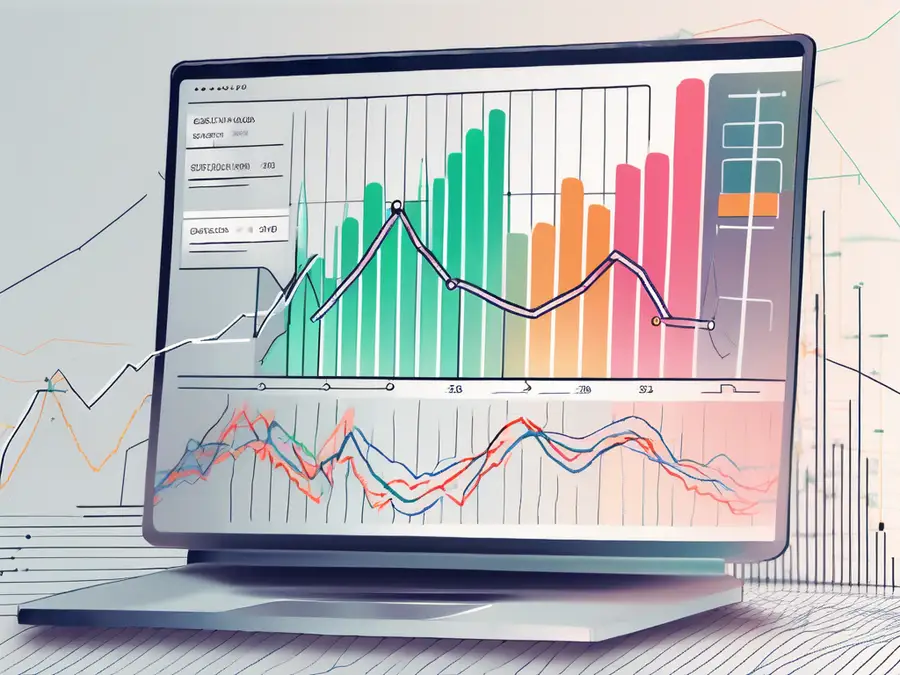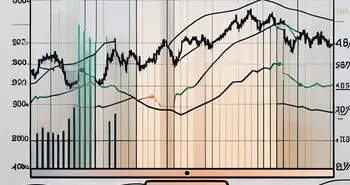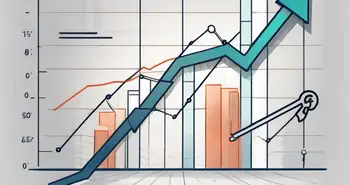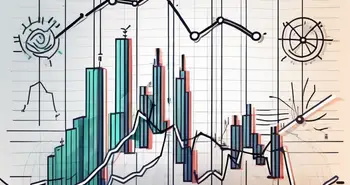Article Contents
Unlocking Trading Insights: A Comprehensive Guide to the Donchian Channel

As an experienced trader, I can confidently say that understanding and utilizing the Donchian Channel can be a game-changer in your trading strategy. In this comprehensive guide, I will take you through the basics, mechanics, significance, strategies, and potential pitfalls of using the Donchian Channel. By the end of this article, you'll have a solid foundation for unlocking valuable trading insights with this powerful tool.
Understanding the Basics of Donchian Channel
The Donchian Channel, also known as the price envelope, is a technical analysis indicator developed by Richard Donchian in the 1970s. It consists of three lines: the upper channel line, the lower channel line, and the middle line, representing the 20-day moving average.
Richard Donchian, a renowned trader and educator, pioneered the concept of trend following and introduced the world to this powerful tool. The Donchian Channel helps traders identify and visualize price breakouts, volatility, and trend reversals.
The History and Development of Donchian Channel
Richard Donchian developed the Donchian Channel as a way to capture and capitalize on market trends. His innovative approach challenged the prevailing wisdom of the time, which focused on predicting short-term price movements.
Donchian's groundbreaking work paved the way for trend following strategies, highlighting the importance of long-term trends in trading. Today, his legacy lives on, as traders continue to use the Donchian Channel to gain valuable insights into market dynamics.
Donchian's journey towards creating the Donchian Channel was not an easy one. He spent years studying market data, analyzing trends, and experimenting with different indicators. Through his extensive research and practical experience, he was able to develop a tool that revolutionized the field of technical analysis.
Donchian's dedication to understanding market dynamics and his relentless pursuit of innovation set him apart from his peers. He believed that by focusing on long-term trends, traders could achieve consistent profits and minimize the impact of short-term market fluctuations.
Key to Donchian's approach was the concept of price breakouts. He observed that when prices broke through the upper or lower channel lines, it often signaled a significant shift in market sentiment. By identifying these breakouts, traders could position themselves to take advantage of emerging trends.
Key Concepts and Terminology
Before delving deeper into the mechanics of the Donchian Channel, it's crucial to understand some essential concepts and terminology:
- Upper Channel Line: The highest high over a specific period, often 20 days, is plotted as the upper boundary of the channel. This line serves as a resistance level, indicating the upper limit of price movement.
- Lower Channel Line: The lowest low over a specific period, usually 20 days, is plotted as the lower boundary of the channel. This line acts as a support level, indicating the lower limit of price movement.
- Middle Line: The 20-day moving average represents the middle line, providing a reference point for assessing price movements. This line helps traders identify the overall trend and potential areas of support or resistance.
- Price Breakouts: When prices break through the upper or lower channel lines, it signifies a significant shift in market sentiment. These breakouts often indicate the start of a new trend or a reversal in the existing trend.
- Volatility: The Donchian Channel can also provide insights into market volatility. When the channel widens, it suggests increased price volatility, indicating potential trading opportunities. Conversely, a narrowing channel indicates decreased volatility, signaling a period of consolidation or indecision in the market.
By understanding these key concepts and terminology, traders can effectively utilize the Donchian Channel to make informed trading decisions. It serves as a valuable tool for identifying trends, managing risk, and maximizing profit potential.
The Mechanics of the Donchian Channel
Now that you have an understanding of the basic concepts, let's explore the mechanics of the Donchian Channel and how it can be applied in your trading strategy.
The Donchian Channel, developed by Richard Donchian, is a technical analysis tool that helps traders identify potential trend reversals or continuations. It operates on the principle that prices tend to break out of historical highs or lows, indicating significant market movements.
The Donchian Channel consists of two boundary lines: the upper channel line and the lower channel line. These lines are drawn around price movements, providing traders with a visual representation of volatility and price ranges. The upper channel line represents the highest high over a specified period, while the lower channel line represents the lowest low over the same period.
Traders often use the Donchian Channel to identify breakouts when price breaches the upper or lower boundary lines. A breakout above the upper channel line may indicate a bullish trend, while a breakout below the lower channel line may suggest a bearish trend. These breakouts can serve as signals to enter or exit trades, depending on the trading strategy employed.
How the Donchian Channel Works
The Donchian Channel works by capturing the volatility and price ranges of a given security or asset. It helps traders visualize the potential trading opportunities and assess the strength of market trends.
When the price breaks above the upper channel line, it signifies a potential bullish breakout. This breakout suggests that buyers are in control, and the price may continue to rise. Traders may consider entering long positions or adding to existing positions to take advantage of the upward momentum.
Conversely, when the price breaks below the lower channel line, it indicates a potential bearish breakout. This breakout suggests that sellers are dominating the market, and the price may continue to decline. Traders may consider entering short positions or reducing existing positions to profit from the downward movement.
It's important to note that breakouts alone are not sufficient to make trading decisions. Traders should consider other factors such as volume, market conditions, and the strength of the breakout before executing trades. Combining the Donchian Channel with other technical indicators can provide more robust signals and increase the accuracy of your trading strategy.
Interpreting the Donchian Channel
While the Donchian Channel is a powerful tool, it's crucial to interpret its signals in the context of the overall market and other indicators. Market conditions and the presence of other technical patterns can influence the reliability of the Donchian Channel's signals.
For example, a breakout above the upper channel line may indicate a bullish trend, but if the overall market sentiment is bearish, the breakout may be a false signal. Traders should consider the broader market context and analyze other indicators, such as moving averages or oscillators, to confirm the validity of the breakout.
Similarly, a breakout below the lower channel line may suggest a bearish trend, but if the market is experiencing strong buying pressure, the breakout may be a temporary pullback rather than a significant reversal. Traders should assess the strength of the breakout and monitor other indicators to avoid false signals.
By combining the Donchian Channel with other technical analysis tools, traders can gain a more comprehensive understanding of market dynamics and make informed trading decisions. It's essential to adapt the Donchian Channel to your trading style and incorporate it into a broader trading strategy that considers multiple factors and indicators.
The Significance of the Donchian Channel in Trading
Now that you understand the mechanics, let's explore the significance of the Donchian Channel in trading and how it can enhance your analysis.
The Donchian Channel is a powerful tool that can provide valuable insights into market trends and volatility. By focusing on price breakouts and the relationship between the upper and lower channel lines, traders can gain a deeper understanding of the strength and duration of a trend.
One of the key roles of the Donchian Channel is trend identification. It excels at identifying trends, both in terms of direction and volatility. During strong trends, the price will often hug one boundary of the Donchian Channel, indicating a consistent and reliable trend. This can be a valuable signal for traders, as it suggests that the trend is likely to continue. Conversely, periods of low volatility may cause the price to remain within the channel, suggesting a range-bound market. This information can help traders adjust their strategies accordingly.
The Role of Donchian Channel in Trend Identification
The Donchian Channel's ability to identify trends is particularly useful for traders. By analyzing the price movements within the channel, traders can gain insights into the strength and duration of a trend. This can help them make more informed decisions about when to enter or exit a trade.
When the price consistently hugs one boundary of the Donchian Channel, it indicates a strong and reliable trend. This means that traders can have more confidence in their positions and potentially ride the trend for longer. On the other hand, if the price remains within the channel, it suggests a range-bound market with low volatility. In such cases, traders may need to adjust their strategies and look for other indicators to validate breakouts.
Volatility and the Donchian Channel
Volatility is a crucial aspect of trading, as it often precedes significant price movements and provides opportunities for profit. The Donchian Channel's upper and lower boundary lines act as a volatility indicator, widening during periods of high volatility and narrowing during calmer markets.
Traders can use this understanding of volatility to adapt their trading strategies accordingly. During times of high volatility, breakouts from the Donchian Channel may carry more significance, as they are more likely to lead to substantial price movements. Traders can take advantage of these breakouts to enter or exit positions and potentially profit from the market's volatility. However, during low volatility, traders may need to exercise caution and consider other indicators to validate breakouts, as they may be less reliable.
In conclusion, the Donchian Channel is a valuable tool for traders, providing insights into market trends and volatility. By understanding its role in trend identification and its relationship with volatility, traders can enhance their analysis and make more informed trading decisions.
Strategies for Using the Donchian Channel
Now that you have a solid understanding of the Donchian Channel's mechanics and significance, let's explore some strategies for incorporating it into your trading approach.
Breakout Trading with the Donchian Channel
One popular approach is breakout trading, which involves entering trades when prices break above the upper boundary line or below the lower boundary line. This strategy assumes that breakouts are indicative of potential trend reversals or continuations.
For example, if a stock breaks above the upper channel line, a trader may choose to enter a long position, anticipating further price appreciation. Conversely, if a stock breaks below the lower channel line, a trader may opt for a short position, expecting the price to decline.
It's important to combine breakout signals from the Donchian Channel with other indicators, such as volume and momentum oscillators, for confirmation and to filter out false breakouts.
Swing Trading with the Donchian Channel
Another strategy is swing trading, which aims to capture shorter-term price movements within the overall trend. Swing traders typically enter trades based on price reversals near the upper or lower channel lines.
For instance, when a stock reaches the upper boundary line of the Donchian Channel, it may be overbought, presenting a potential selling opportunity. Conversely, when a stock approaches the lower boundary line, it may be oversold, indicating a potential buying opportunity.
Swing traders often combine the Donchian Channel with other technical indicators, such as oscillators or candlestick patterns, to increase the accuracy of their trading signals.
Potential Pitfalls and Risks of Using the Donchian Channel
While the Donchian Channel is a valuable tool, it's important to be aware of potential pitfalls and risks associated with its use. Let's explore some common challenges and ways to mitigate these risks.
Overcoming Common Challenges
One common challenge traders face when using the Donchian Channel is distinguishing between true breakouts and false signals. Breakouts can sometimes be short-lived, resulting in whipsaw movements that can lead to losses. Traders can mitigate this risk by waiting for confirmation from other indicators before entering a trade.
Additionally, it's crucial to consider the overall market conditions and the context in which breakouts occur. Breakouts during periods of low volume or range-bound markets may lack the momentum necessary for a sustained move.
Mitigating Risks with the Donchian Channel
Risks can be mitigated by carefully managing risk-reward ratios and employing appropriate risk management techniques, such as setting stop-loss orders. By defining predetermined exit points and adhering to risk management principles, traders can protect their capital and minimize potential losses.
Furthermore, thorough backtesting and forward testing of trading strategies can provide valuable insights into their performance and help traders identify the optimal parameters for the Donchian Channel.
Optimizing Your Use of the Donchian Channel
To maximize the effectiveness of the Donchian Channel in your trading, consider incorporating it into a comprehensive trading strategy. Let's explore some ways you can optimize your use of this powerful tool.
Combining the Donchian Channel with Other Indicators
The Donchian Channel can be a valuable complement to other technical indicators and chart patterns. By combining it with oscillators, moving averages, or trend-following indicators, you can generate more robust trading signals and increase the likelihood of capturing profitable trades.
For example, combining the Donchian Channel with the Relative Strength Index (RSI) can help identify overbought or oversold conditions, strengthening your decision-making process.
Tips for Maximizing Trading Success with the Donchian Channel
Here are some additional tips to help you maximize your trading success with the Donchian Channel:
- Periodically review and optimize the parameters of the Donchian Channel based on market conditions and historical data.
- Practice proper risk management by setting stop-loss orders and adhering to predetermined risk-reward ratios.
- Stay abreast of market news and economic factors that may impact the accuracy of the Donchian Channel's signals.
- Consider using automation tools and algorithms to take advantage of trading opportunities that align with the Donchian Channel's signals.
Expert Advice: As an experienced trader, I have found that patience and discipline are key when using the Donchian Channel. It's important to wait for confirmed breakouts or reversals and avoid chasing false signals. Don't forget to combine the Donchian Channel with other indicators to increase the quality of your trading signals. Consistency is the name of the game when it comes to successful trading, and the Donchian Channel can be a valuable ally in your journey.
FAQs
Q: How is the Donchian Channel different from other technical analysis indicators?
A: The Donchian Channel is unique in its ability to capture trends and visualize volatility. While other indicators focus on specific aspects of price movement, such as momentum or mean reversion, the Donchian Channel provides a holistic view of price ranges and breakouts.
Q: Can the Donchian Channel be used in different markets?
A: Yes, the Donchian Channel can be applied to various markets, including stocks, commodities, and forex. However, it's essential to adapt the parameters of the Donchian Channel based on the specific characteristics of each market.
Q: What is the optimal period length to use for the Donchian Channel?
A: The optimal period length for the Donchian Channel depends on the timeframe you're trading and the characteristics of the market. While the default period of 20 days is commonly used, it's recommended to conduct thorough backtesting to identify the most effective period length for your trading strategy.
Q: Can the Donchian Channel be used in conjunction with fundamental analysis?
A: Absolutely! The Donchian Channel can complement fundamental analysis by providing a technical perspective on price movements. By combining the two approaches, traders can gain a comprehensive understanding of market dynamics and make well-informed trading decisions.
As an experienced trader, I can confidently say that understanding and utilizing the Donchian Channel can be a game-changer in your trading strategy. In this comprehensive guide, I have taken you through the basics, mechanics, significance, strategies, and potential pitfalls of using the Donchian Channel. By following the insights and recommendations shared here, you are well on your way to unlocking valuable trading insights and achieving success in your trading endeavors.
Ready to put the Donchian Channel into action and elevate your trading to new heights? Join Morpher, the revolutionary trading platform that's redefining the investing landscape. With Morpher, you can seamlessly apply the insights from the Donchian Channel across a variety of markets, from stocks to sneakers, all with zero fees, infinite liquidity, and the safety of a non-custodial wallet. Whether you're looking to engage in fractional investing, short selling, or leverage up to 10x, Morpher provides a unique, blockchain-based trading experience that empowers you to trade on your terms. Sign Up and Get Your Free Sign Up Bonus today, and start trading with an edge.

Disclaimer: All investments involve risk, and the past performance of a security, industry, sector, market, financial product, trading strategy, or individual’s trading does not guarantee future results or returns. Investors are fully responsible for any investment decisions they make. Such decisions should be based solely on an evaluation of their financial circumstances, investment objectives, risk tolerance, and liquidity needs. This post does not constitute investment advice.

Painless trading for everyone
Hundreds of markets all in one place - Apple, Bitcoin, Gold, Watches, NFTs, Sneakers and so much more.

Painless trading for everyone
Hundreds of markets all in one place - Apple, Bitcoin, Gold, Watches, NFTs, Sneakers and so much more.








